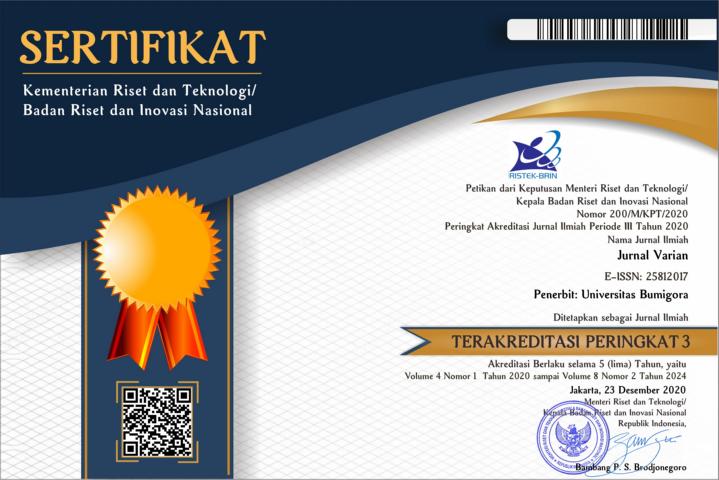The Weibull Regression Model Analysis of Mahakam River Water Pollution Potential
Abstract
Mahakam River has a vital role in the lives of the people of the East Kalimantan province, including
providing a raw source of clean water. The multi-activity of the Mahakam River watershed, as a water
traffic lane, mining, fisheries, hotels, restaurants, and resident houses, has the potential to produce waste
into the water. Increasing waste in the water flow can increase the pollution potential of river water,
threatening people’s health. Therefore, precaution is necessary. In this research, statistical prevention
was proposed, providing information to the East Kalimantan people regarding the factors affecting the
pollution potential of the Mahakam River through Weibull regression (WR) modeling on dissolved oxygen (DO) data 2022. Research data was secondary data provided by the Life Environmental Department
of East Kalimantan province. The WR model is a Weibull distribution that is directly influenced by covariates. WR model consists of Weibull survival regression, cumulative distribution regression, hazard
regression, and Weibull mean regression. This research aims to obtain the factors affecting the pollution potential and to provide the pollution potential information of Mahakam River 2022. The research
concluded that factors influencing the pollution potential of the Mahakam River were watercolor degree
and nitrate concentration. Applying the WR model to DO data 2022 was able to provide the pollution
potential information of Mahakam River, namely the probability of river water isn’t polluted is 0.6555,
or the probability of the polluted river water is 0.3445, the pollution rate is 6 locations are polluted for
every 10 mg/L DO, and the DO average of river water is 5.7450 mg/L. Increasing water color degree
and nitrate concentration will decrease the probability of the Mahakam River being polluted, increase
the probability of the Mahakam River being polluted, increase the pollution rate, and reduce the DO of
Mahakam River water.
References
Using Weibull Distribution. Procedia Engineering, 90, 725–732. https://doi.org/10.1016/j.proeng.2014.11.803
Azizah, N., Suyitno, S., & Hayati, M. N. (2023). Pemodelan Laju Kematian Pasien Covid-19 di RSUD Abdul Wahab Sjahranie
Samarinda menggunakan Model Regresi Weibull. Journal of Mathematics Computations and Statistics, 6(1), 17–30.
https://doi.org/10.35580/jmathcos.v6i1.36379
Collett, D. (2023, May). Modelling Survival Data in Medical Research (4th ed.). Chapman; Hall/CRC. https://doi.org/10.1201/
9781003282525
Dimitrova, D. S., Kaishev, V. K., & Tan, S. (2020). Computing the Kolmogorov-Smirnov Distribution When the Underlying CDF is
Purely Discrete, Mixed, or Continuous. Journal of Statistical Software, 95(10), 1–42. https://doi.org/10.18637/jss.v095.
i10
Fajriati, N. A., Suyitno, S., & Wasono, W. (2022). Model Regresi Hazard Rate Weibull Kesembuhan Pasien Rawat Inap Demam
Berdarah Dengue (DBD) di RSUD Panglima Sebaya Tanah Grogot. EKSPONENSIAL, 13(1), 35–44. https://doi.org/10.
30872/eksponensial.v13i1.878
Fardiaz, S. (1992). Polusi Air dan Udara (Cet. 1). Kanisius.
Inayah, U. R., Suyitno, S., & Siringoringo, M. (2021). Upaya Pencegahan Pencemaran Air Sungai Mahakam melalui Pemodelan
Geographically Weighted Logistic Regression pada Data BOD. EKSPONENSIAL, 12(1), 17–26. https://doi.org/10.30872/
eksponensial.v12i1.755
Khairunnisa, S. F., Suyitno, S., & Mahmuda, S. (2023). Weibull Regression Model on Hospitalization Time Data of COVID-19
Patients at Abdul Wahab Sjahranie Hospital Samarinda. Jurnal Matematika, Statistika dan Komputasi, 19(2), 286–303.
https://doi.org/10.20956/j.v19i2.22266
Olivera, S., & Heard, C. (2019). Increases in the extreme rainfall events: Using the Weibull distribution. Environmetrics, 30(4), 1–9.
https://doi.org/10.1002/env.2532
Panduwinata, H. D., Suyitno, S., & Huda, M. N. (2022). Model Regresi Weibull Pada Data Kontinu yang Diklasifikasikan. EKSPONENSIAL, 13(2), 123–130. https://doi.org/10.30872/eksponensial.v13i2.1051
Pemerintah Republik Indonesia. (2022). Peraturan Pemerintah Republik Indonesia Nomor 22 Tahun 2021 Tentang Penyelenggaraan Perlindungan dan Pengelolaan Lingkungan Hidup.
Rencher, A. C., & Schaalje, G. B. (2008). Linear Models in Statistics (2nd ed). Wiley-Interscience.
Rinne, H. (2008, November). The Weibull Distribution: A Handbook. Chapman; Hall/CRC.
Shu, Z. R., & Jesson, M. (2021). Estimation of Weibull parameters for wind energy analysis across the UK. Journal of Renewable
and Sustainable Energy, 13(2), 1–18. https://doi.org/10.1063/5.0038001
Sugiarto, S., Suyitno, S., & Rizki, N. A. (2021). Model Geographically Weighted Univariat Weibull Regression pada Data Indikator
Pencemaran Air Dissolve Oxygen di Daerah Aliran Sungai Mahakam Kalimantan Timur Tahun 2018. EKSPONENSIAL,
12(2), 185–192. https://doi.org/10.30872/eksponensial.v12i2.813
Suyitno, S. (2017). Penaksiran Parameter dan Pengujian Hipotesis Model Regresi Weibull Univariat. EKSPONENSIAL, 8(2), 179–
183. https://doi.org/10.30872/eksponensial.v8i2.41
Suyitno, S., Nohe, D. A., Purnamasari, I., Siringoringo, M., Goejantoro, R., & Rahmah, M. N. (2022, December). Monograf:
Pemodelan Regresi Weibull Pada Potensi Pencemaran Sungai Mahakam. Penerbit Perkumpulan Rumah Cemerlang
Indonesia. https://www.rcipress.rcipublisher.org/index.php/rcipress/catalog/book/398
Yuliantari, R. V., Novianto, D., Hartono, M. A., & Widodo, T. R. (2021). Pengukuran Kejenuhan Oksigen Terlarut pada Air menggunakan Dissolved Oxygen Sensor. Jurnal Fisika Flux: Jurnal Ilmiah Fisika FMIPA Universitas Lambung Mangkurat,
18(2), 101–104. https://doi.org/10.20527/flux.v18i2.9997

This work is licensed under a Creative Commons Attribution 4.0 International License.


















